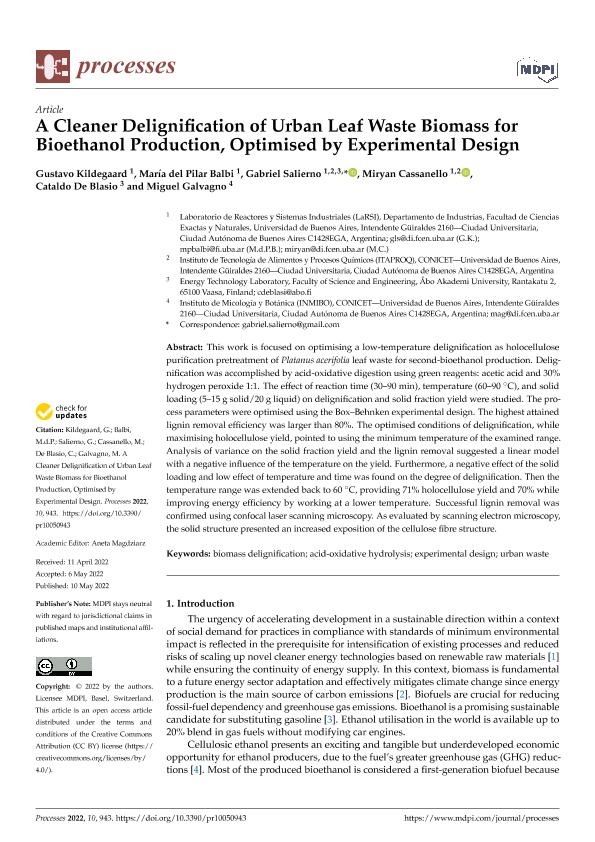Artículo
A Cleaner Delignification of Urban Leaf Waste Biomass for Bioethanol Production, Optimised by Experimental Design
Kildegaard, Gustavo ; Balbi, María del Pilar; Salierno, Gabriel Leonardo
; Balbi, María del Pilar; Salierno, Gabriel Leonardo ; Cassanello, Miryan; De Blasio, Cataldo; Galvagno, Miguel Angel
; Cassanello, Miryan; De Blasio, Cataldo; Galvagno, Miguel Angel
 ; Balbi, María del Pilar; Salierno, Gabriel Leonardo
; Balbi, María del Pilar; Salierno, Gabriel Leonardo ; Cassanello, Miryan; De Blasio, Cataldo; Galvagno, Miguel Angel
; Cassanello, Miryan; De Blasio, Cataldo; Galvagno, Miguel Angel
Fecha de publicación:
05/2022
Editorial:
MDPI
Revista:
Processes
ISSN:
2227-9717
Idioma:
Inglés
Tipo de recurso:
Artículo publicado
Clasificación temática:
Resumen
This work is focused on optimising a low-temperature delignification as holocellulose purification pretreatment of Platanus acerifolia leaf waste for second-bioethanol production. Delig-nification was accomplished by acid-oxidative digestion using green reagents: acetic acid and 30% hydrogen peroxide 1:1. The effect of reaction time (30–90 min), temperature (60–90◦C), and solid loading (5–15 g solid/20 g liquid) on delignification and solid fraction yield were studied. The process parameters were optimised using the Box–Behnken experimental design. The highest attained lignin removal efficiency was larger than 80%. The optimised conditions of delignification, while maximising holocellulose yield, pointed to using the minimum temperature of the examined range. Analysis of variance on the solid fraction yield and the lignin removal suggested a linear model with a negative influence of the temperature on the yield. Furthermore, a negative effect of the solid loading and low effect of temperature and time was found on the degree of delignification. Then the temperature range was extended back to 60◦C, providing 71% holocellulose yield and 70% while improving energy efficiency by working at a lower temperature. Successful lignin removal was confirmed using confocal laser scanning microscopy. As evaluated by scanning electron microscopy, the solid structure presented an increased exposition of the cellulose fibre structure.
Archivos asociados
Licencia
Identificadores
Colecciones
Articulos(INMIBO (EX - PROPLAME))
Articulos de INSTITUTO DE MICOLOGIA Y BOTANICA
Articulos de INSTITUTO DE MICOLOGIA Y BOTANICA
Articulos(ITAPROQ)
Articulos de INSTITUTO DE TECNOLOGIA DE ALIMENTOS Y PROCESOS QUIMICOS
Articulos de INSTITUTO DE TECNOLOGIA DE ALIMENTOS Y PROCESOS QUIMICOS
Citación
Kildegaard, Gustavo; Balbi, María del Pilar; Salierno, Gabriel Leonardo; Cassanello, Miryan; De Blasio, Cataldo; et al.; A Cleaner Delignification of Urban Leaf Waste Biomass for Bioethanol Production, Optimised by Experimental Design; MDPI; Processes; 10; 5; 5-2022; 1-18
Compartir
Altmétricas



